What exactly is SLS 3D Printing Technology?
- Locanam 3D Printing

- Oct 11, 2023
- 3 min read
Updated: Feb 19, 2024
Selective laser sintering (SLS) is a widely employed additive manufacturing technology known for its ability to generate a diverse range of models, patterns, objects, and products. This method relies on sintering powdered plastic material, as implied by its name. Through the precise application of laser beams, SLS transforms nylon-based powders into robust, solid plastic structures. This utilization of nylon-based powders enhances the strength and durability of the 3D printed products and prototypes.
SLS 3D printers are versatile machines capable of producing both finished products and prototypes, making use of a wide range of materials, including plastics, glass, and ceramics. Numerous businesses leverage SLS 3D printing technology for the production of small quantities of high-quality products or parts. Notably, the aerospace industry extensively employs SLS 3D printers to create prototypes for airplane components, thereby saving time and resources that would have been otherwise invested. Enterprises can easily adapt and customize these prototypes by making adjustments to the CAD/CAM-based design diagram.
What Is the Mechanism Behind SLS 3D Printing?
SLS (Selective Laser Sintering) 3D printing technology is utilized to create objects and models by employing powdered polymer build materials. SLS 3D printers are equipped with a re-coating tool responsible for introducing fresh powder materials into the process chamber. A high-powered laser is employed to heat the powder after scanning a cross-section of the 3D model. This process results in the mechanical fusion of particles, forming a solid structure. Subsequently, the build platform descends one layer at a time into the build chamber after each layer is completed.
The re-coating tool is responsible for applying a fresh layer of powder over the initial one. A laser then scans the next cross-section of the model to be printed. This process continues until the entire product or part is fully 3D printed. Following completion, the printer places the model inside the build chamber to allow it to cool and solidify. Once removed from the build chamber, the printer proceeds to clean the 3D-printed model to eliminate any excess powder.
Why should you consider choosing SLS 3D printing technology?
Supports Not Required
In contrast to various other 3D printing methods, SLS (Selective Laser Sintering) does not necessitate the use of support structures. The use of powders in SLS simplifies the process of 3D printing intricate designs and geometries, eliminating the need for additional support structures.
Accelerate Processes SLS 3D printers offer manufacturers the advantage of accelerating both the prototyping and production phases. Beyond their inherent speed as an additive manufacturing technology, SLS expedites prototyping through the utilization of high-powered lasers. These lasers possess the capacity to swiftly scan and fuse powders, resulting in increased efficiency.
Improved Output Quality
Selective Laser Sintering (SLS) empowers manufacturers with the ability to utilize robust and versatile materials, such as nylon. This high-quality thermoplastic, nylon, enables manufacturers to craft products and prototypes that exhibit both the visual and functional characteristics akin to those produced through traditional manufacturing methods.
Prepared Products for Immediate Use
Engineers can utilize the SLS printer for crafting prototypes during the design phase and for manufacturing end-user products during the production phase. This eliminates the need for additional time dedicated to testing end-user products separately. Furthermore, the ability to make pertinent modifications to the prototype allows for easy customization and adaptation of the end-user products. conclusion
Selective Laser Sintering (SLS) 3D printing technology stands as a versatile and efficient method for generating a wide array of models and functional products. With its ability to create intricate designs without the need for support structures, SLS accelerates both prototyping and production processes, all while delivering high-quality results. The use of robust materials like nylon enhances the durability of products and prototypes, ultimately streamlining the path from design to production. SLS technology offers engineers the convenience of immediate customization, making it a valuable asset in various industries, including aerospace.




Comments